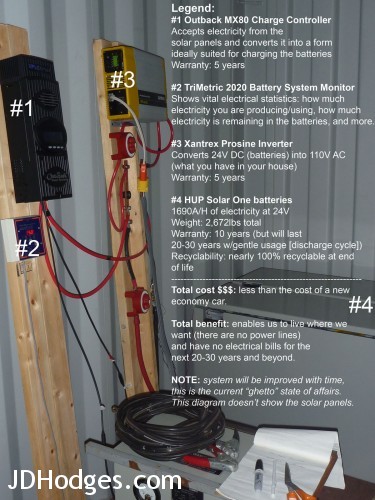A milestone for our solar powered home
2009.09.04 updated with URLs for equipment (see bottom of post)
Since we’ve been married, Samantha and I have lived off the grid. We don’t have any utility bills and we haven’t had a single power outage. However, today (September 3rd, 2000) still marks a big day for us in our off the grid living. Because today we connected our new batteries and solar setup to our house. We now have over 30x the electrical storage capacity!
Energy during the day is produced by solar panels. We use some of it and the excess is stored in the batteries. During the night we use the batteries as our sole source of electricity. Previously we had plenty of electricity during the day, but in the evenings we had to monitor our power usage fairly carefully.
Now at night time Samantha can use her 24″ monitor, I can use my 27″ monitor, we can turn lots of lights on, and we can run just about anything else we want. I could do some welding right now if I wanted to! This is really a treat for us. Not having it before, means we really appreciate it now :-).
Currently the setup is ugly, but it is working perfectly. This post is being written with power generated from the sun, stored in those batteries, and output with this setup. Here is a photo showing practically all the components required (other than panels, wiring and breakers, which are not shown). It’s really not that complex of a system but it is works wonderfully.

Shows some of the "backend" components of an off the grid setup. (click the photo for a larger, more legible, version)
Thanks for sharing in this milestone for our home :-).
PS Three notes:
#1 Why? Someone interested in solar asked me what prompted my family to start using solar, the reasons are:
+independence: we like to produce our own electricity and be relatively independent of external circumstances
+choice of living place: solar is one of the only viable options where we live
+environmental friendliness: solar is clean. There are some up front environmental production costs for the panels, but over the lifespan of the panel it will produce much more electricity than it cost to build the panel.
#2 Cost. I am not saying that solar is cheaper than living on the grid, because it is not cheaper as of 2009. However, while utility prices may go up in the future, the costs of this system will not go up. It is already been paid for and now it simply produces electricity for the rest of its lifespan (and my family has panel and batteries older than me [29 years old] that are still working). Likewise, for new installations, these electrical components (much like computers) generally get cheaper and more efficient over time, rather than more expensive.
#3 To each their own. I am not advocating solar for everyone, it just works really well for us and our purposes. If you think it is something that will work well for you too, that is awesome! If it doesn’t seem like your cup of tea, that’s cool too.
PS here is a transcript of the photo description:
Legend:
#1 Outback MX80 Charge Controller
Accepts electricity from the solar panels and converts it into a form ideally suited for charging the batteries
Cost: $392 (purchased on eBay w/30% Bing/live.com cashback, price before cashback was $560)
Warranty: 5 years
#2 TriMetric 2020 Battery System Monitor
Shows vital electrical statistics: how much electricity you are producing/using, how much electricity is remaining in the batteries, and more.
Cost: $140.67
#3 Xantrex Prosine Inverter – 1800 watts
Converts 24V DC (batteries) into 110V AC (the voltage you need for your house)
Warranty: 5 years
Cost: $660 (eBay, new in box)
#4 HUP Solar One batteries
1690A/H of electricity at 24V
Weight: 2,672lbs total
Warranty: 10 years (but will last 20-30 years w/gentle usage [discharge cycle])
Recyclability: nearly 100% recyclable at end of life
Costs: $6,848
————————————————————-
Total cost $$$: less than the cost of a new economy car (this is even including the panels, which are not included in the photo).
Total benefit: enables us to live where we want (there are no power lines) and have no electrical bills for the next 20-30 years and beyond.
PHOTO NOTE: system will be improved with time, this is the current “ghetto” state of affairs. This diagram doesn’t show the solar panels.
Note to readers: This is not set up in the house…for the very reason that it’s not “pretty” ;-)!
HOWEVER! Awesome power…just awesome!
Good clarification :-).
JD, awesome setup! thanks for sharing!
Thanks guys!
Awesome!
Thanks for using it, and thanks for sharing it here. Cheer!